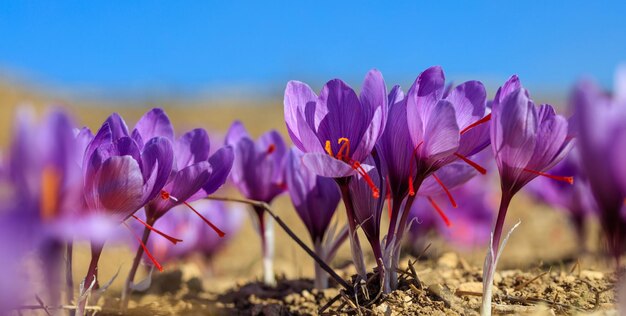Saffron, derived from the stigma of the Crocus sativus flower, is one of the most expensive spices in the world, known for its unique flavor, aroma, and vibrant color. With the increasing demand for saffron in local and international markets, South African farmers can capitalize on this lucrative crop. This article provides a detailed overview of the process of growing saffron from seed to harvest, including growth stages, inputs required, potential pests and diseases, and best practices for successful cultivation.
Overview of Saffron Cultivation
Saffron is typically grown from corms rather than seeds, making the planting process somewhat different from traditional crops. These corms are bulb-like structures that store nutrients and energy for the plant.
1. Land Preparation
- Soil Type: Saffron thrives in well-drained, sandy loam to loamy soils with a pH between 6.0 and 8.0. It is crucial to ensure good drainage to prevent waterlogging, which can lead to corm rot.
- Field Selection: Choose a site that receives full sunlight and has good air circulation to reduce humidity around the plants.
- Tillage: Prepare the soil by plowing to a depth of about 30 cm. This will aerate the soil and help eliminate weeds.
- Soil Amendments: Before planting, incorporate organic matter, such as compost or well-rotted manure, to improve soil fertility and structure.
2. Planting Saffron Corms
- Corm Selection: Choose healthy, disease-free corms, ideally 8-10 cm in diameter, as larger corms tend to produce more flowers and higher yields.
- Planting Time: In South Africa, saffron corms are typically planted in late summer (August to September) to coincide with the cooler, dry months.
- Planting Depth: Plant corms 10-15 cm deep, with a spacing of 15-20 cm between each corm. This allows adequate room for growth and minimizes competition.
- Machinery and Tools: A hand trowel or small mechanical planter can be used for planting. Avoid deep tillage after planting to protect the corms.
3. Growth Stages
Germination (Weeks 1-2)
- Corms will start to sprout within a few weeks. Ensure adequate soil moisture during this period but avoid waterlogging.
- Water Requirements: Saffron requires about 300-500 mm of water during the growing season, mainly through rain. If rainfall is insufficient, irrigate lightly.
Vegetative Growth (Weeks 3-8)
- During this phase, saffron plants develop green leaves. Maintain soil moisture and apply nitrogen-rich fertilizers to promote healthy leaf growth.
- Fertilizers: Use a balanced fertilizer (N-P-K 10-10-10) at a rate of about 400 kg per hectare, applying half at planting and half during the vegetative stage.
- Pest and Disease Monitoring: Watch for fungal diseases like corm rot and leaf blight. Proper air circulation and avoiding excessive watering will help mitigate these risks.
Flowering (Weeks 9-12)
- Saffron blooms in late autumn (October to November), producing beautiful purple flowers. Each flower yields three red stigmas, which are harvested for saffron.
- Harvesting: Harvest flowers early in the morning when they are fully open, typically once a year. Collect the stigmas by hand, as this process is delicate and requires care to avoid damage.
Corm Development and Dormancy (Weeks 13-16)
- After flowering, the plants enter a dormancy period. Do not water during this time (December to March), as the corms store energy for the next growing season.
- Soil Management: Avoid disturbing the soil during dormancy. Maintain weed control through mulching or light hand weeding.
4. Harvesting and Storage
- Harvesting Techniques: Hand-harvest the saffron stigmas carefully, using scissors to avoid damaging the flower. Each flower should yield about 0.5-1.0 g of dry saffron.
- Drying Process: Dry the harvested stigmas immediately to preserve their quality. Use a dehydrator or spread them on a screen in a cool, dark place with good air circulation.
- Storage: Store dried saffron in airtight containers, away from light and moisture, to maintain its flavor and potency. Properly stored saffron can last for several years.
5. Pest and Disease Management
- Common Pests: Watch for aphids, spider mites, and thrips. Regular monitoring and the use of organic insecticides (such as neem oil) can help manage these pests.
- Diseases: Corm rot caused by excess moisture and fungal infections can be detrimental. Fungicides can be applied preventively, but proper soil management and drainage are the best defenses.
- Weed Control: Weeds can compete with saffron for nutrients and water. Use mulch or hoeing to control weeds during the vegetative phase.
6. Machinery and Inputs
- Machinery: Minimal machinery is required for saffron cultivation, but small tractors or tillers can be helpful for land preparation. Hand tools like trowels and harvesters are crucial during planting and harvesting.
- Watering Equipment: Drip irrigation systems can be beneficial in managing water supply, especially during dry spells.
Growing saffron can be a rewarding venture for South African farmers, offering a high-value crop with unique market potential. By understanding the growth stages, proper land preparation, pest management, and harvesting techniques, farmers can maximize their yields and profits. With the right practices and care, saffron cultivation can contribute positively to sustainable farming practices and economic growth in South Africa.
Join 'Farmers Mag' WhatsApp Channel
Get the latest Farming news and tips delivered straight to your WhatsApp
CLICK HERE TO JOIN






